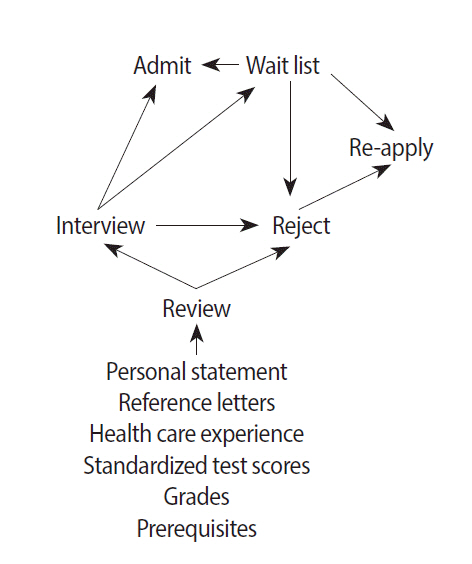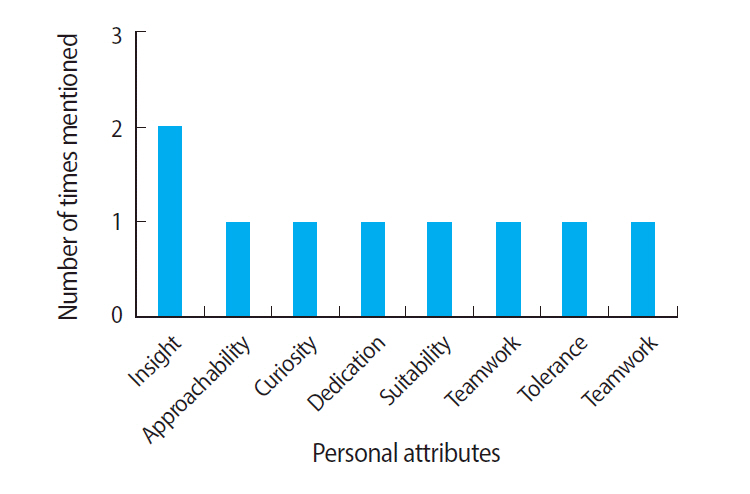J Educ Eval Health Prof.
2014;11:11. 10.3352/jeehp.2014.11.11.
Imperfect physician assistant and physical therapist admissions processes in the United States
- Affiliations
-
- 1Department of Physician Assistant Studies, University of Texas Southwestern Medical Center, Dallas, TX, USA. eugene.jones@utsouthwestern.edu
- 2Department of Physical Therapy, University of Texas Southwestern Medical Center, Dallas, TX, USA.
- 3Ambulatory Specialty Clinic, Parkland Health & Hospital System, Dallas, TX, USA.
- KMID: 2380930
- DOI: http://doi.org/10.3352/jeehp.2014.11.11
Abstract
- We compared and contrasted physician assistant and physical therapy profession admissions processes based on the similar number of accredited programs in the United States and the co-existence of many programs in the same school of health professions, because both professions conduct similar centralized application procedures administered by the same organization. Many studies are critical of the fallibility and inadequate scientific rigor of the high-stakes nature of health professions admissions decisions, yet typical admission processes remain very similar. Cognitive variables, most notably undergraduate grade point averages, have been shown to be the best predictors of academic achievement in the health professions. The variability of non-cognitive attributes assessed and the methods used to measure them have come under increasing scrutiny in the literature. The variance in health professions students' performance in the classroom and on certifying examinations remains unexplained, and cognitive considerations vary considerably between and among programs that describe them. One uncertainty resulting from this review is whether or not desired candidate attributes highly sought after by individual programs are more student-centered or graduate-centered. Based on the findings from the literature, we suggest that student success in the classroom versus the clinic is based on a different set of variables. Given the range of positions and general lack of reliability and validity in studies of non-cognitive admissions attributes, we think that health professions admissions processes remain imperfect works in progress.
Keyword
MeSH Terms
Figure
Cited by 1 articles
-
Preadmission predictors of graduation success from a physical therapy education program in the United States
Gretchen Roman, Matthew Paul Buman, Sun Huh
J Educ Eval Health Prof. 2019;16:5. doi: 10.3352/jeehp.2019.16.5.
Reference
-
1. Strand J, Price P, Scott V, Dieter PM. Team process exercise: an evaluative admissions tool. Persp Physician Assist Educ. 2003; 14:154–157. http://www.paeaonline.org/index.php?ht=d/ContentDetails/i/59750.
Article2. Dieter PM, Carter RD, Rabold JS. Automating the complex school admission process to improve screening and tracking of applicants and decision-making outcomes. Persp Physician Assist Educ. 2011; 11:25–34. http://www.paeaonline.org/index.php?ht=d/ContentDetails/i/59699.
Article3. Skaff KO, Rapp DA, Fahringer D. Predictive connections between admissions criteria and outcomes assessment. Persp Physician Assist Educ. 1998; 9:75–78. http://www.paeaonline.org/index.php?ht=d/ContentDetails/i/59837.4. Thrasher A. Factoring leadership into the admissions process. J Physician Assist Educ. 2012; 23:49. http://www.paeaonline.org/index.php?ht=d/ContentDetails/i/141679.
Article5. Felix H, Laird J, Ennulat C, Donkers K, Garrubba C, Hawkins S, Hertweck M. Holistic admissions process: an initiative to support diversity in medical education. J Physician Assist Educ. 2012; 23:21–27. http://www.paeaonline.org/index.php?ht=d/ContentDetails/i/142702.
Article6. Forister JG, Jones PE, Liang M. Thematic analysis of personal statements in physician assistant program admissions. J Physician Assist Educ. 2011; 22:6–12. http://www.paeaonline.org/index.php?ht=d/ContentDetails/i/127975.
Article7. Jones PE, Forister JG. A comparison of behavioral and multiple mini-interview formats in physician assistant program admissions. J Physician Assist Educ. 2011; 22:36–40. http://www.paeaonline.org/index.php?ht=d/ContentDetails/i/124206.
Article8. Accreditation Review Commission on Education for the Physician Assistant, Inc. Accredited entry-level programs [Internet]. Johns Creek, GA: ARC-PA; [cited 2013 Dec 30] Available from: http://www.arc-pa.org/acc_programs/.9. Commission on Accreditation in Physical Therapy Education. Number of PT and PTA programs as of December 12, 2013 [Internet]. Alexandria, VA: American Physical Therapy Association; [cited 2013 Dec 30] Available from: http://www.capteonline.org/uploadedFiles/CAPTEorg/About_CAPTE/Resources/Aggregate_Program_Data/Number ofPTPTAPrograms.pdf.10. Commission on Accreditation in Physical Therapy Education. 2012-2013 fact sheet, physical therapy education programs [Internet]. Alexandria, VA: American Physical Therapy Association; [cited 2014 Jan 2] Available from: http://www.capteonline.org/uploadedFiles/CAPTEorg/About_CAPTE/Resources/Aggregate_Program_Data/AggregateProgramData_PTPrograms.pdf.11. Physician Assistant Education Association. 27th annual report: physician assistant educational programs in the United States [Internet]. Alexandria, VA: Physician Assistant Education Association; [cited 2013 Dec 30] Available from: http://www.paeaonline.org/index.php?ht=a/GetDocumentAction/i/149930.12. Salvatori P. Reliability and validity of admissions tools used to select students for the health professions. Adv Health Sci Educ Theory Pract. 2001; 6:159–175.13. Norman G. The morality of medical school admissions. Adv Health Sci Educ Theory Pract. 2004; 9:79–82. http://dx.doi.org/10.1023/A:1011489618208.14. Brown G, Imel B, Nelson A, Hale LS, Jansen N. Correlations between PANCE performance, physician assistant program grade point average, and selection criteria. J Physician Assist Educ. 2013; 24:42–45. http://www.paeaonline.org/index.php?ht=d/ContentDetails/i/148809.
Article15. Higgins R, Moser S, Dereczyk A, Canales R, Stewart G, Schierholtz C, Ruback TJ, McDaniel J, Van Rhee J, Arbuckle S. Admission variables as predictors of PANCE scores in physician assistant programs: a comparison study across universities. J Physician Assist Educ. 2010; 21:10–17. http://www.paeaonline.org/index.php?ht=d/ContentDetails/i/105128.
Article16. Zipp GP, Ruscingo G, Olson V. Admission variables and academic success in the first year of the professional phase in a doctor of physical therapy program. J Allied Health. 2010; 39:138–142.17. Utzman R, Riddle DL, Jewell D. Use of demographic and quantitative admissions data to predict academic difficulty among professional physical therapy students. Phys Ther. 2007; 87:1164–1180. http://dx.doi.org/10.2522/ptj.20060221.18. Kulatunga-Moruzi C, Norman GR. Validity of admissions measures in predicting performance outcomes: the contributions of cognitive and non-cognitive dimensions. Teach Learn Med. 2002; 14:34–42. http://dx.doi.org/10.1207/S15328015TLM1401_9.19. Chew BH, Zain AM, Hassan F. Emotional intelligence and academic performance in first and final year medical students: a cross-sectional study. BMC Med Educ. 2013; 13:44. http://dx.doi.org/10.1186/1472-6920-13-44.
Article20. Zakariasen KV, Boyatzis RE. What is the relationship between emotional intelligence and dental student clinical performance? J Dent Educ. 2013; 77:416–426. http://www.jdentaled.org/content/77/4/416.long.21. Lewis E. Longitudinal assessment of emotional intelligence of doctor of physical therapy students. Internet J Allied Health Sci Pract. 2011; 9(2):http://ijahsp.nova.edu/articles/Vol9Num2/Lewis.htm.22. Galleher C, Rundquist PJ, Barker D, Chang WP. Determining cognitive and noncognitive predictors of success on the national physical therapy exam. Internet J Allied Health Sci Pract. 2012; 10(4):http://ijahsp.nova.edu/articles/Vol10Num4/Galleher.htm.23. Vendrely A. An investigation of the relationship among academic performance, clinical performance, critical thinking and success on the physical therapy licensure examination. J Allied Health. 2007; 36:e108–e123.24. Eva KW, Reiter HI. Where judgment fails: pitfalls in the selection process for medical personnel. Adv Health Sci Educ Theory Pract. 2004; 9:161–174. http://dx.doi.org/10.1023/B:AHSE.0000027479.14637.6c.25. Albanese MA, Snow MH, Skochelak SE, Huggett KN, Farrell PM. Assessing personal qualities in medical school admissions. Acad Med. 2003; 78:313–321. http://journals.lww.com/academicmedicine/Fulltext/2003/03000/Assessing_Personal_Qualities_in_Medical_School.16.aspx.
Article26. Shen H, Comrel AL. Predicting medical students’ academic performances by their cognitive abilities and personality characteristics. Acad Med. 1997; 72:781–786. http://journals.lww.com/academicmedicine/pages/articleviewer.aspx?year=1997&issue=09000&article=00013&type=abstract.
Article27. Goho J, Blackan A. The effectiveness of academic admission interviews: an exploratory meta-analysis. Med Teach. 2006; 28:335–340. http://dx.doi.org/10.1080/01421590600603418.
Article28. Eva KW, Rosenfeld J, Reiter HI, Norman GR. An admissions OSCE: the multiple mini-interview. Med Educ. 2004; 38:314–326. http://dx.doi.org/10.1046/j.1365-2923.2004.01776.x.
Article29. Hayes K, Huber G, Rogers J, Sanders B. Behaviors that cause clinical instructors to question the clinical competence of physical therapy students. Phys Ther. 1999; 79:653–667. http://ptjournal.apta.org/content/79/7/653.30. McDaniel MJ, Thrasher A, Hiatt T. The use of noncognitive factors in physician assistant admissions. J Physician Assist Educ. 2013; 24:15–23. http://www.paeaonline.org/index.php?ht=d/ContentDetails/i/148803.
Article31. Physical Therapy Centralized Application Service. Professionalism & core values [Internet]. Watertown, MA: American Physical Therapy Association; 2012 [cited 2014 Jan 2] Available from: http://www.ptcas.org/Professionalism/.32. CNNMoney. Best jobs in America: 8. Physical therapist [Internet]. Cable News Network; 2012 [cited 2014 Jan 6] Available from: http://money.cnn.com/pf/best-jobs/2012/snapshots/8.html.33. CNNMoney. Best jobs in America: 16. Physician assistant [Internet]. Cable News Network; 2012 [cited 2014 Jan 6]. Available from: http://money.cnn.com/pf/best-jobs/2012/snapshots/16.html.34. Morris JG. The value and role of the interview in the student admissions process: a review. Med Teach. 1999; 21:473–481. http://dx.doi.org/10.1080/01421599979149.
Article
- Full Text Links
- Actions
-
Cited
- CITED
-
- Close
- Share
- Similar articles
-
- Review for the Curriculum and License Exam of Physical Therapists in the United States
- Physician payment reform in the United States
- Developing a situational judgment test blueprint for assessing the non-cognitive skills of applicants to the University of Utah School of Medicine, the United States
- Cultural competency in a physician assistant curriculum in the United States: a longitudinal study with two cohorts
- Promoting collaboration and cultural competence for physician assistant and physical therapist students: A cross-cultural decentralized interprofessional education (IPE) model





